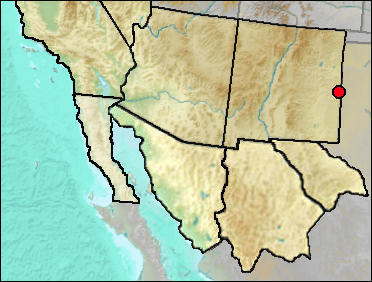 Age. Late Wisconsin; ca. 13-11 kya (Haynes 1995). Haynes
(1964) gave the Brown Sand Wedge portion as 11,170 ± 360 BP (A-481).
Age. Late Wisconsin; ca. 13-11 kya (Haynes 1995). Haynes
(1964) gave the Brown Sand Wedge portion as 11,170 ± 360 BP (A-481).
General Description. The site consists of Wisconsin-age sediments laid down in a spring-fed pond. Gravel-pit operations brought attention to the fossil deposits, and the finding of an association between early man and mammoth has resulted in major studies of the site. A summary of work at Blackwater Loc. No. 1 is in Hester (1972).
Discussion. The early hunters have become known as Clovis, after the nearby town of Clovis, New Mexico. The fossil fauna has been summarized in the literature largely as from two units: Gray Sand (Lundelius 1972) and Brown Sand Wedge (Slaughter 1975). The Gray Sand is the earliest unit of pond sediments. Hester (1972) cited Haynes as believing it is full pluvial, between 13,000 and 25,000 BP. The average thickness is about 3 ft. Deposits suggest a time of ample and steady water supply. It appears that the Clovis artifacts recovered from the Gray Sand are intrusive, having been deposited on the surface of the sediment. Lundelius (1972) cited Haynes and Agogino (1966) as confirming a springhead origin for the gray sand.
Lundelius (1972) cited earlier work on the gray sand by Stock and Bode (1937), who reported most of the species. The list given here of that portion of the fauna that comes from the Gray Sand is from Lundelius (1972). However, the specimen of the large tortoise, cf. Hesperotestudo, was thought by Lundelius to have been reworked from older deposits and is not cited here.
Slaughter (1975) noted that the geographic range of the Eastern Box Turtle today (all subspecies) is within the >30" precipitation area. He also noted that the closest related subspecies today (Terrapene carolina major, of the Gulf Coast) is in an area with more than 300 frost-free days. He attributes presence of Dasypus bellus as indicating more moisture and "winters no more severe and probably somewhat milder" than today. He also noted (presumably after Mohlhenrich [1961]) that the Hispid Cotton Rat's northern limit conforms to a line of average January temperature of 35° F. Microtus pennsylvanicus at its southern limits is north of areas with normal daily maxima of 90° F and normal average July temperatures not exceeding 82° F. Slaughter (1975) showed a figure with current ranges of the Meadow Vole and Masked Shrew in relation to temperature (with an approximate southern boundary formed by an isotherm of >60 days with temperatures higher than 60° F; the area to north has a July normal maximum daily temperatures <87° F). He suggested trees, at least in the valley itself, more effective moisture, and mild winters. Mean winter temperatures may have been little higher, but it is doubtful that severe cold fronts occurred.
Graham (1987) apparently followed (without comment) the suggestion of Harris (1990) that the gray squirrel represented is Sciurus carolinensis rather than S. arizonensis. Slaughter (1975:190) stated that "Our modern climate must be more severe, as regards variation of temperature, than that which these areas have endured for many thousands of years."
Slaughter (1975) omits a species account for Microtus ochrogaster, but includes it in his list of taxa recovered.
Following Morgan and Lucas (2005), the faunas from the Gray Sand and from the Brown Sand Wedge are combined here as the Blackwater Draw Fauna.
Fauna
Amphibia
Lithobates pipiens—Leopard Frog
Reptilia
Thamnophis sauritus—Common Garter Snake
Thamnophis sirtalis—Ribbon Snake
Lampropeltis triangulum—Milk Snake (cf. gen. et sp.)
Heterodon nasicus—Western Hog-nosed Snake (cf.)
Chelonia
†Hesperotestudo wilsoni—Wilson's Tortoise (cf.)
†Terrapene carolina putnami—Putnam's Eastern Box Turtle
Aves
Buteo jamaicensis—Red-tailed Hawk
Buteo regalis—Ferruginous Hawk
Haliaeetus sp.—Bald Eagle (Johnson 1986)
Cathartes aura—Turkey Vulture
Falco columbarius—Merlin
Anas sp.—Puddle Ducks
Branta canadensis—Canada Goose
Mammalia
Didelphis virginiana—Virginia Opossum
†Mammuthus columbi—Columbian Mammoth
†Dasypus bellus—Beautiful Armadillo
†Paramylodon harlani—Harlan's Ground Sloth
Cynomys ludovicianus—Black-tailed Prairie Dog
Sciurus sp.—Tree Squirrel (Reported as S. cf. arizonensis by Slaughter, 1975;
see Sciurus account)
Dipodomys ordii—Ord's Kangaroo Rat
Geomys bursarius—Plains Pocket Gopher(cf.)
Microtus mogollonensis—Mogollon Vole (?)
Microtus ochrogaster—Prairie Vole (?)
Microtus pennsylvanicus—Meadow Vole
Ondatra zibethicus—Common Muskrat
Neotoma sp.—Woodrat
Peromyscus leucopus—White-footed Mouse (?)
Peromyscus truei—Pinyon Mouse (?)
Reithrodontomys megalotis— (?)
Sigmodon hispidus—Hispid Cotton Rat
Lepus californicus—Black-tailed Jackrabbit
Sylvilagus sp.—Cottontail
Sorex cinereus—Masked Shrew
†Smilodon fatalis—Sabertooth
†Canis dirus—Dire Wolf
Canis latrans—Coyote
Canis lupus—Gray Wolf
Urocyon cinereoargenteus—Gray Fox
Vulpes velox—Swift Fox
Vulpes vulpes—Red Fox (cf.)
Ursus americanus—Black Bear
Mephitis mephitis—Striped Skunk
Procyon lotor—Raccoon
†Equus conversidens—Mexican Horse
†Equus niobrarensis—Niobrara Horse
†Platygonus compressus—Flat-headed Peccary
†Camelops hesternus—Yesterday's Camel
†Hemiauchenia macrocephala—Big-headed Llama
Odocoileus hemionus—Mule Deer
Antilocapridae—(large) Pronghorn
†Capromeryx furcifer—Matthew's Pronghorn (?)
†Bison antiquus—Ancient Bison
†Bison priscus—Steppe Bison
"Clovis area"
Literature. Harris 1985a, 1990a ; Harris and Porter 1980; Haynes1995; Haynes and Agogino 1966; Hester 1967, Hester 1972; Johnson 1986, 1987; Lundelius 1972; Milstead 1967; Morgan and Lucas 2005; Slaughter 1975; Stock and Bode 1937.
Last Update: 5 Apr 2013